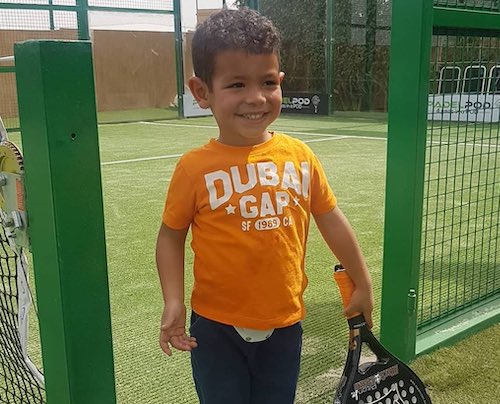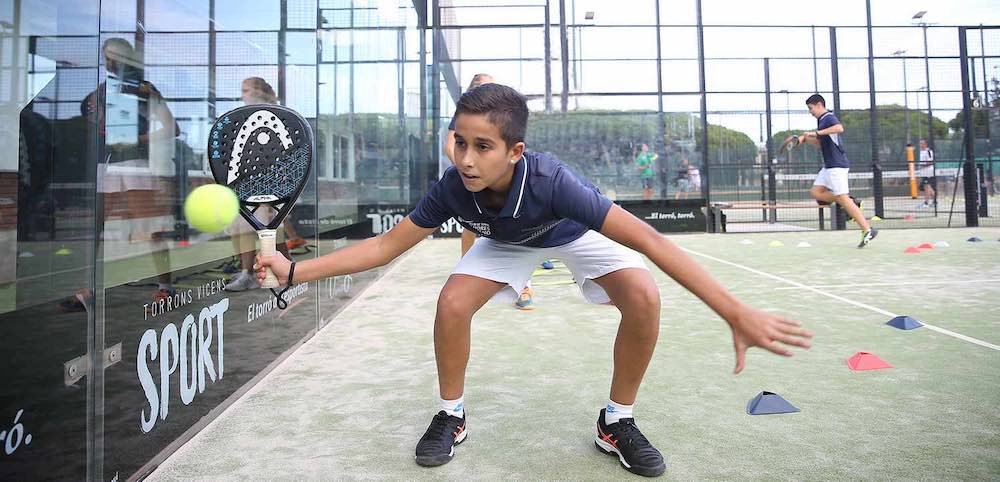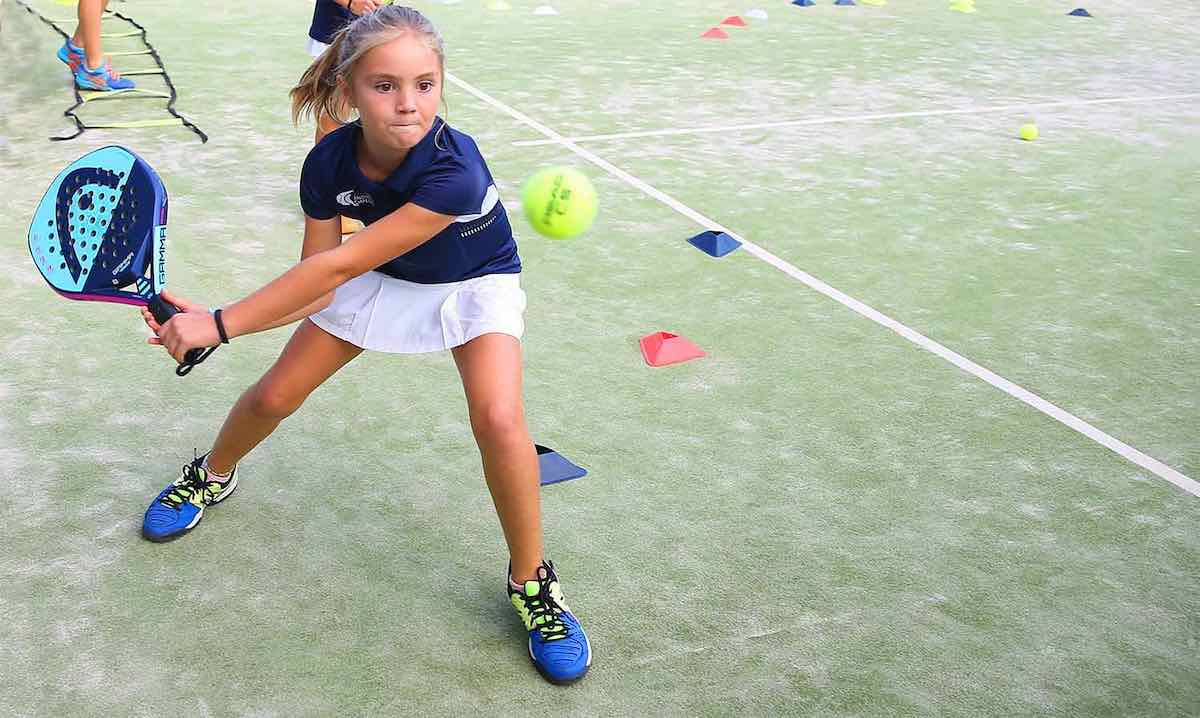Padel is a competitive sport that helps children learn a new skill, gain confidence and make friends on and off the court.
It brings many benefits like physical coordination and balance and is a fun activity that can boost self-esteem. The question is, what is the best age to introduce children to the sport?
Let’s look go over the basics and benefits of playing Padel. We’ll look at how to find your local padel court, how to motivate children and get them into sports, and the Padel rules for beginners.
At what age can children start Padel lessons?
Children can start playing kids Padel at a young age, even as toddlers. This is because sports like Padel allow them to develop their motor skills, give them the experience of overcoming challenges, and teach them teamwork as you have to move around the court as a pair.
Let’s go through children at each stage of their development and see how their relationship with Padel can grow as they do. We’ll see how they can improve as padel players.
From ages 4 to 7

Enrolling young children in padel lessons allows them to learn from the experts. It allows them to exercise while supervised by responsible adults passionate about the game.
At such a young age, it’s important to raise your child’s self-esteem, encouraging them and giving them an incentive to play. They’ll have enough energy to play if you keep them excited.
They should have fun playing Padel and focus on teaching them the right movements without boring them. Sessions should be full of fun drills that pique a child’s interest and build their passion.
The best thing you can do is encourage your kids to enjoy their time playing along. You will need to look for a padel court near your area and the best padel rackets for beginners.
Between the ages of 8 and 9
Sports like Padel are vital for a child’s development because it enhances their motor skill, promote values like teamwork and accepting loss, and improve their coordination and balance.
This is the ideal time to start, as children aged 8-10 are more likely to stay in the sport than a younger kid because they will have happy memories of playing with their family and friends.
At this point, your local Padel club will begin combining fun activities with skills-based drills and teaching the children the rules of Padel. They will have more experience using the rackets and bouncing balls.
You must invest in a good-quality junior padel racket to start your kid off. They may rest it on the court or smack it around as kids do, so it’s best to get a durable one.
From the ages of 10 to 12

Padel is one of the most excellent physical activities for a growing kid because it makes them more flexible, agile, and coordinated. It’s also a good time to give them a social group they can relate to.
The best padel players often start playing Padel or other racket sports at this age. They can perform movements properly and are at the age where parents invest in high-quality rackets and shoes.
At this stage, the racket activity becomes an excellent after-school activity. Balancing school and sports will teach your kid time management, delayed gratification, and the value of punctuality.
From the ages of 13 to 15
It’s at this stage where children who have played Padel for the past few years get their chance to shine. They will begin to play a competitive sport and devote themselves to Padel.
At this age, they will first join junior padel events, especially if they’re from Spain and other Padel countries. This will create an environment that helps them to see Padel less as an exercise and more as a positive life direction.
Children competing in the sport will learn how to perform the different shots of Padel. They will eat through Padel rackets as they become more powerful and obsessed with the sport.
If you are a parent of a child who loves playing Padel, you must invest in high-quality Padel rackets.
From the ages of 16 and forward
Your children are growing up. If they’ve made it this far, they’ll likely continue playing Padel well into adulthood.
Congratulations, you’ve fostered an environment that allows them to enjoy Padel and do what they love!
Isabella Torres of SimplePadel
After spending years of practice developing their skills for each Padel match, your children are now reaping the benefits of your chosen sport. They have discipline, physical ability, and passion.
It isn’t too late for adults who didn’t grow up with a padel racket in their hand. Padel is a sport that works for many people regardless of age or fitness level.
You will need a padel racket and some good padel shoes to get into the sport. You may not learn as quickly as the kids, but you’ll still be able to participate and enjoy a game or two.
Padel exercises for kids
Young children first being introduced to racket sports don’t start with a racket in their hand, especially if they’re young. Instead, they start learning the basics through related drills and games.
These exercises are fun ways of ensuring skills development and increasing their speed, accuracy, and agility. They even improve a shy child’s ability to play a team sport.
Here are some popular examples of Padel-related games that help foster a love for the event in kids:
The worm drill
This game is similar to the old cellphone app “Snake,” wherein the snake maneuvers around to eat the dots on the screen. In this case, however, the kids are the snakes, and the balls are the dots.
The worm is a fun drill where the kids can only move with side steps and lateral movement. The balls are rolled towards them, and they must learn to avoid the balls by letting them pass between their legs.
Chicken Killer
This game trains the kids’ reaction times and enhances their reflexes. The kids are lined against the court wall and are given a set number of lives until they’re out.
Their job is to use their lateral and body movement to dodge their coach’s balls thrown at them. This builds up their speed, endurance, and even stress management.
Bounce and catch
This simple, seemingly straightforward exercise builds up the basics: hand-eye coordination. The goal is simple: bounce the ball to your partner for them to catch it. You can be as close or as far as possible.
This builds a player’s reflexes while giving them muscle memory. It also trains the children to see the ball bounce before interacting with it, which is a major part of what makes Padel unique.
Why you should play Padel games
When children are first introduced to the sport, they won’t be coordinated or patient enough to learn the regulations and fundamentals of the sport without getting bored.
You will need to make it interesting. These drills are a good way to teach them the proper movements while giving them something to look forward to.
If your child is starting with these games, you must encourage them and give them positive reinforcement every step.
They may forget the fundamentals and techniques, but they will not forget the fun they had playing Padel. This will make them lifelong Padel fans even if they stop playing.
Finding Your Local Padel Court
Many parents would not consider Padel for their kids simply because they’ve never heard of it and assume it’s not popular enough to be sustainable. That couldn’t be farther from the truth.
While Padel is a game primarily played in Spain and Latin America, it’s rapidly increasing in popularity in the US and UK. This development means that it’s becoming more mainstream and accessible.
A child can easily get into padel tennis because of the availability of padel rackets and courts, padel club memberships being on the rise, and the sport growing in popularity in Spain and Hispanic countries.
This gives them the benefits of years of experience playing, rapid development, and a deep-seated love of the sport.
Recommended reading; Where to play Padel in the US?
Summary
Padel is a fun sport that kids can get into and greatly benefit from. By playing Padel, they get to improve their physical skills like balance and maneuverability.
A child that plays team sports like Padel also grows more sociable on and off the court. They can even excel at the sport and play competitively at the Junior Padel and later World Padel level.
Frequently asked questions about getting kids interested in Padel
Children and parents looking to get their children into the sport will have a few concerns about how to give their children an edge or keep them safe while doing this physical activity.
It’s important to note that Padel is easier than other racket sports like tennis. It’s safer for a child, and playing Padel can introduce kids to a world of benefits.
Anyone can play Padel, especially a child. Padel is a lower-intensity sport compared to its other companions. It’s a great way for parents looking to get their kids into tennis sports.
Padel is a good sport for people regardless of age, as it is good for older adults who can’t sprint as fast and kids who just learned how to walk. A child can start to play padel tennis at 4 years of age.
It’s never too late to start playing Padel. However, many professional World Padel Tour players started when they were children, with a few starting when they were only 5 years of age. The average age champion Padel competitors start in the sport is 14-15.
Some exercises include catching drills, passing the ball back and forth over chairs, and rotating around a chair while passing the balls back to the coach.

Isabella Torres is originally from Madrid, Spain, and has been playing Padel as a semi-professional for the past five years. After completing her education as a journalist, she discovered her true passion in life was writing about Padel.
She loves staying up late watching intense rallies on YouTube, and is excited to share her knowledge about the sport with SimplePadel’s readers.

6 replies on “Kids Padel: Get them to share your interest in playing Padel”
[…] kids also have the potential to be the next World Padel Tour players. Practicing Padel while at a young age is a good start. Hence, appropriate clothing shouldn’t only be for adults but kids as […]
[…] You can try to play normal padel but within the service lines as a half court game. This is also a great way of playing padel with kids. […]
[…] can also rent courts per the hour (with or without partner). Padel Life & Soccer also offer an academy for children that wish to try out the […]
[…] courts must apply and agree to the terms and conditions. They even offer a special club called Kids Connection as part of their Padel Development Program. A part from this, amnesties […]
[…] Furthermore, Taktika offers a plethora of tournaments and leagues as well as summer camp for kids wanting to play padel. […]
[…] offer weekly classes, private lessons, and great atmospheres for all types of players, including kids. If you’re looking to have some fun with friends or get some serious practice in, either of these […]